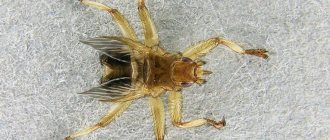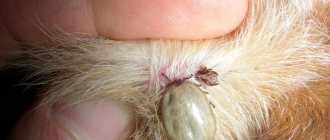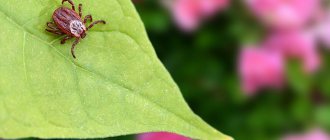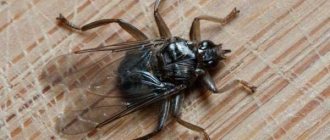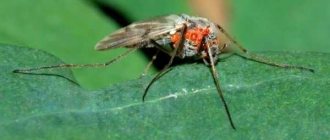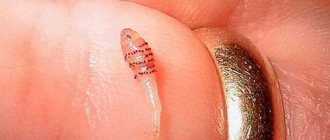In previous articles, we examined in detail such representatives of the ixodid family as taiga and dog ticks, which are most common in the central zone of our country. Having the ability to infect humans with complex infectious diseases, they attract more attention from us.
However, the Ixodid family includes another type of tick, which has many names - deer, bear, black-legged or simply black tick. This type of parasite does not officially live on the territory of our continent; its habitat is mainly North America. But it is worth noting that single representatives of the parasite can be found on any landmass of the planet, with the exception of regions with permafrost.
Considering the peculiarities of the distribution of the black tick, the material in this article may be useful to tourists, travelers, as well as those readers who want to broaden their horizons in the field of entomology of ixodid ticks.
General information about the black mite
The black-legged tick (Ixodes scapularis) is commonly known as the deer tick, black-legged tick, or black-legged tick due to the intense lacquered black coloring of its limbs. The tick's habitat is primarily on the west coast of the United States, but is found throughout the continent. Like most members of the ixodid family, the black tick is a carrier of several animal and human diseases - Lyme disease, babesiosis, anaplasmosis and others. The true host of the black tick is the white-tailed deer, and it is precisely because the parasite is most often found on this animal that it has earned its second name, the deer tick. The tick also attacks mice, lizards and migratory birds; this phenomenon is especially often observed at the larval or nymphal stage of the parasite.
Features of behavior
I. scapularis has a life cycle of two years, during which it passes through three stages: larva, nymph and adult. The tick must take a portion of blood at each stage of its life cycle before maturation, otherwise the transition to the next stage will be impossible.
The black tick is one of the species of ixodids in which the process of feeding on blood takes a long time. After landing on a victim, the parasite quickly finds a place to bite, but the process of taking blood continues for four to five days. As noted above, white-tailed deer are the preferred host of the black tick, but they are also well known to attack small rodents.
After the parasite gets drunk, it falls to the ground and hibernates in the fallen leaves of the undergrowth. The following spring, the female lays several hundred to several thousand eggs in clusters.
Ixodid ticks are very hardy creatures and I. scapularis is no exception. They are active even after severe frosts, since daytime temperatures can warm them enough to keep them in the desired host-seeking activity. In the spring, they may be one of the first invertebrate animals to emerge after winter.
Description
Most images of Ixodes scapularis show an adult that has not consumed food. This is natural because black-legged ticks are removed immediately upon discovery to minimize the likelihood of disease.
Typically, the abdominal cavity, which contains blood, is much larger when feeding. Consequently, a swollen I. scapularis parasite (see photo below) can easily be mistaken for an entirely different tick.
When a black tick consumes blood, its abdomen is a light grayish-blue color. When identifying a live parasite, it is helpful to focus on the legs and upper body.
Consequences of a bite
In addition to Lyme disease, or borreliosis, the black tick is dangerous to humans as a carrier of several other types of pathogens, such as Theileria microti and Anaplasma phagocytophilum, which cause the diseases babesiosis and human granulocytic anaplasmosis, respectively. Concurrent infections are often possible—among early patients with Lyme disease, depending on their geographic location, 2-12% also have anaplasmosis and 2-40% have babesiosis. Co-infection will complicate Lyme symptoms, but diagnosis and treatment are especially difficult in this case.
Although large mammals are the preferred hosts of ticks, deer cannot transmit Lyme disease pathogens to ticks. They acquire Borrelia while feeding in their early stages on infected mice and other small rodents.
Guinea fowl, backyard chickens, and fire ants are known predators of mites. However, in the wild, an increase in populations of this ant species has no effect on reducing the concentration of mites.
Distribution area of the encephalitis virus
Ticks live on almost the entire Eurasian continent, but not everywhere there is a high risk of contracting a dangerous disease. Mostly dangerous are parasites that inhabit a very narrow strip that runs in the middle of Eurasia.
At the same time, there is a clear geographical division between the different types of viruses: the European type is widespread up to the Urals, and the Far Eastern type is widespread beyond the Urals to the Far East. The main source of encephalitis is sick animals, and this serious disease is transmitted by blood-sucking insects, including ticks.
The highest degree of tick infestation is observed in the Asian part of Russia. According to experts, up to 20% of ticks here are infected.
Some features of the black tick development cycle
Black mites live for two to three years and feed only three times in their entire lives. The life cycle begins when the female lays eggs. As the eggs mature, they hatch into larvae, which then molt into nymphs and finally, also through the molting process, the nymphs emerge into adults.
Larvae emerge from eggs, as a rule, from May to September, that is, the entire warm period of the season. Here are a few characteristics of this stage of the mite:
- initially the larva is sterile, it does not carry pathogens of diseases such as Lyme disease, human anaplasmosis or babesiosis;
- the first causative agent of the disease, the larva receives a portion of blood from the carrier or sick host during its intake;
- the larvae usually attack white mice, voles, or bite the legs of other small mammals;
- if a mouse is infected with pathogens, the larva becomes infected and is now able to transmit these pathogens during its second or third feeding (nymph or adult stage);
- immediately after feeding, the larvae molt into nymphs and become passive until the following spring.
In the spring and summer of the second year, primarily from May to early July, the nymph becomes active and feeds for the second time in its life. Peculiarities:
- If a tick carries a pathogen acquired during its first feeding as a larva, it may transmit the pathogen during its second feeding.
- If the nymph has not yet been infected, it may become infected if the second host carries pathogens.
- The nymph is the size of a poppy seed. Therefore, it is very difficult to distinguish them externally; they often look like a speck of dirt or freckles on human skin.
In the fall of the second year, the nymphs molt into adult ticks. Females acquire a red or orange body color and are much larger. The main distinguishing feature of the species, black legs, becomes the most noticeable.
The adult female receives a blood supply from large animals in the fall or early spring, after which she lays eggs and then dies.
If the tick is unable to drink blood in the fall, they go into a dormant state for the entire winter, and then continue to look for hosts in the spring of the following year.
Frost is not harmful to ticks. Adults can become active as soon as spring temperatures rise above freezing. In some cases, ticks acquire a certain mottled color immediately after the onset of a temporary thaw in winter.
As already noted, the blood sucking of the female tick continues for several days. During this time, their bodies slowly increase several dozen times their original state. Adult females infected with disease-causing agents at the larval or nymphal stages can transmit the disease while feeding.
The situation is completely different with male black mites. They do not feed on blood at all, but only on plant juices, but they still move to the owner to meet the female.
Some facts about the black tick
- Black ticks feed on blood by inserting their proboscis into the wound, which is equipped with sharp growths that prevent the tick from falling off until the feeding process is completed.
- They are very slow bloodsuckers - to get their fill of blood, they need a period of 3-5 days.
- If black-legged ticks are infected with an infectious agent, the blood-sucking time must take at least 24-48 hours before the parasite is able to infect a person with Lyme disease. Human anaplasmosis takes slightly less time to become infected - at least 12-24 hours.
- Ticks live in wooded, brushy areas that provide food and cover for populations of white mice, deer and other mammals.
- This habitat also provides the parasites with the moisture levels they need to survive.
- The highest concentration of ticks is in the forest (especially along highways) and grass areas at the forest border.
- Ticks wait for potential prey at the tips of low-lying vegetation and the lower branches of shrubs. They don't crawl into trees.
- Typically, ticks attach to a person or animal near ground level.
- Like all ixodids, black ticks only crawl, they do not jump or fly. They grab with their front paws the clothes of people or the fur of animals that pass by, and then the bloodsuckers crawl up to find a place to bite.
- White-tailed deer live throughout most of the United States, but the black-legged tick can only be found in certain regions of the country.
Security measures
Of course, it is difficult to refuse a trip to nature, but this is not necessary, just take the problem seriously and do not neglect safety measures. The first thing to do is choose the right clothes. Choose a jacket or cardigan with cuffs and a collar that fits tightly to your neck, thereby protecting it. Be sure to wear hats. Choose pants that can be tucked into socks. Also, be sure to tuck your jacket into your pants. This will block access to your body. Inspect each other's clothing for ticks.
Parasites wake up with the first warmth and become active at a temperature of +5°. Optimal conditions are when the temperature does not exceed +20°. On hot days they are not active and hide in thickets and wet areas.
Not many people can resist picking a beautiful flower and smelling it. This is not worth doing. There are cases where, while sniffing a fragrant flower, the black-legged parasite entered the respiratory tract. It is very difficult to remove it from this area.
How to protect yourself from a tick bite
Black ticks live in shady, damp areas at ground level. They will cling to tall grass, inflorescences and bushes, usually no more than one and a half meters from the ground. They are also abundant in lawns and gardens, especially along woodland edges and around old stone walls. As already noted, parasites cannot fly or jump, nor do they fall on passing people or animals. All the conditions discussed below will be true for “our” parasites - taiga and dog ticks.
In tick-infested areas, the best defense against the parasite is to avoid contact with soil, leaf litter and vegetation. However, if there is a need to hike, camp, hunt, or otherwise spend time outdoors, everyone can protect themselves by:
- Wear light-colored clothes made of thick fabric. It's so easy to see the tick.
- Wear high-top shoes with the legs tucked in and a long-sleeved shirt.
- Check clothing and any exposed skin as often as possible while outdoors.
- Consider using repellents.
- Try to move on cleared, well-trodden trails in their center. Avoid dense forests and bushy areas.
- Avoid sitting directly on the ground or on rock walls.
- Keep long hair tied up.
- Shower as soon as possible after returning indoors, preferably within two hours, to wash off or easily locate any ticks that may be on your body.
- Do a final, full body check at the end of the day. Children and pets should also be checked. Found ticks must be destroyed.
Habitat
The meadow tick is an inhabitant of deciduous and mixed forests of Siberia and Europe. Since this species is very similar morphologically to the pasture tick, they are confused. Sometimes, in general terms, both species are called grass mites. This name is more suitable for a grazing animal, which prefers to live in dry steppe biotopes with herbaceous vegetation.
Meadow tick
Lugovoi has one of its additional names: swamp. This name clearly indicates the parasite’s preferred habitat:
- water meadows;
- edge of deciduous forest;
- forest glades.
The meadow tick also lives in pastures. Able to withstand spring floods. In areas of livestock grazing, mass reproduction of Dermacentor reticulata is observed.
What chemicals are best for protection against ticks?
The following drugs have the most effective acaricidal effects against ixodid ticks:
- DEET. Such substances can be applied to exposed skin. Products containing 20% or more DEET may provide protection that lasts up to several hours. Use the lowest concentration needed for the amount of time you plan to spend outdoors.
- Picaridin is a colorless and odorless ingredient that can be applied to exposed skin at levels ranging from 5 to 20% of the active ingredient.
- Permethrin. Clothing, shoes and personal items can be treated with products containing permethrin. Its protection can last for many washes. Never use permethrin on your skin.
Precautions when using repellents that contain these active ingredients:
- Keep all anti-tick products out of the reach of children and read all label instructions before applying.
- Do not allow children to apply repellents on themselves.
- Do not apply repellents directly to the skin of the body. First you need to apply the product to the palms of your hands. And then treat the skin of the body. The exception is sprays.
- When using repellents, avoid contact with the eyes, mouth and nasal cavity.
- Do not apply repellents to skin damaged by sunburn, cuts, bruises, or other conditions such as psoriasis.
- Avoid prolonged and excessive use of repellents.
- Do not use repellents in enclosed spaces.
- Do not apply them directly to your face.
- Do not apply near eyes, nose or mouth.
- Wash treated skin upon return.
- If you think you or your child have had an adverse reaction to a repellent, wash the treated area immediately and contact your local health care provider.
Signs of the presence of a parasite
Dust mites are present in every home, but not all people have a strong reaction to their presence. It's all about the strength of the immune system, which restrains or allows the development of a response.
Reaction to the presence of dust mites
The most basic symptom is allergies. It manifests itself in the form of skin rashes or a deterioration in general well-being. The reaction can be temporary or permanent, and often develops into chronic diseases.
- Skin symptoms - redness, itching, rash. They intensify after contact with allergens. In most cases after sleep.
- Dust book mites live in large numbers in libraries and in houses where books have been sitting on shelves for years. Over several years, a thick layer of dust accumulates, which indicates intense activity of parasites. Paper mites are present in offices, especially storerooms. In this case, the body’s reaction often manifests itself in the form of sneezing, coughing, rhinitis, headache, and weakness. Unpleasant symptoms disappear after the person leaves the room.
- Carpet mites, as well as inhabitants of soft toys, curtains, and interior items, more often provoke common signs of allergies - rhinitis, lacrimation, conjunctivitis, sneezing, coughing, difficulty breathing. Parasites contribute to the development of bronchial asthma and provoke frequent attacks.
- Bed, mattress, and feather mites can cause a local or systemic reaction on the skin.
With an allergy to house dust, improvement in well-being may occur when a person leaves the room or sleeps in another place. This situation is characterized by frequent manifestations of an allergic reaction and the development of atopic dermatitis.
Main symptoms:
- skin rashes;
- itching;
- rhinitis;
- cough without other signs of a cold;
- lacrimation;
- conjunctivitis;
- headache;
- weakness;
- low immunity;
- frequent colds;
- atopic dermatitis;
- bronchial asthma;
- sneezing.
Dust mites on the face contribute to the development of allergies, as well as acne and inflamed pimples.
How to safely remove a tick
If you find an embedded tick, there is no need to panic. Not all ticks are infected, and your risk of contracting an infection is greatly reduced if the tick is removed within the first 36 hours.
To remove a tick:
- Use simple tweezers to grasp the tick as close to the surface of the skin as possible.
- Pull firmly and steadily vertically upward. Do not pull or twist the tick.
- Place the parasite in a small container of alcohol to kill it. Or just burn it.
- Clean the bite area with alcohol, hydrogen peroxide, or iodine.
The bite site should be monitored over the next 30 days for the appearance of a rash. If a rash or flu-like symptoms begin to appear, contact your doctor immediately. Although it is not generally recommended that you take antibiotics for three days after a tick bite, it may be helpful for some people. This applies to tick bites that occurred in areas where Lyme disease is common and there is evidence that the tick was bitten for more than one day.
Why are they dangerous for animals?
For domestic animals, they are no less dangerous and can cause infection with the following diseases:
- Encephalitis. It is the most common and often affects dogs and cats. If an animal is infected, symptoms appear in the form of fever and lack of appetite. The animal becomes lethargic and does not show interest in others. Urinary retention occurs, tremors appear in the body, and coordination of movements may be impaired.
- Borrelosis. Symptoms of this disease appear only 10 days after the bite. They are similar to the previous option, but an additional rash appears. The animal also begins to limp from time to time.
- Bartonellosis. In this case, the symptoms are different. The animal's eyelids become inflamed, weakness and fever appear. The animal cannot stand on its hind legs normally, severe weakness of the limbs is noticeable.
The worst and most dangerous thing about these diseases is failure to diagnose them in a timely manner. After all, many do not pay attention to the first symptoms and associate them with a common cold. By not paying attention to the symptoms, precious time is lost and the disease progresses to complex stages.
In animals, identifying the disease is a little easier because the symptoms are pronounced. You need to contact a veterinarian on the same day as soon as you notice any discomfort, since the development process is quite fast and there is no time to waste.
